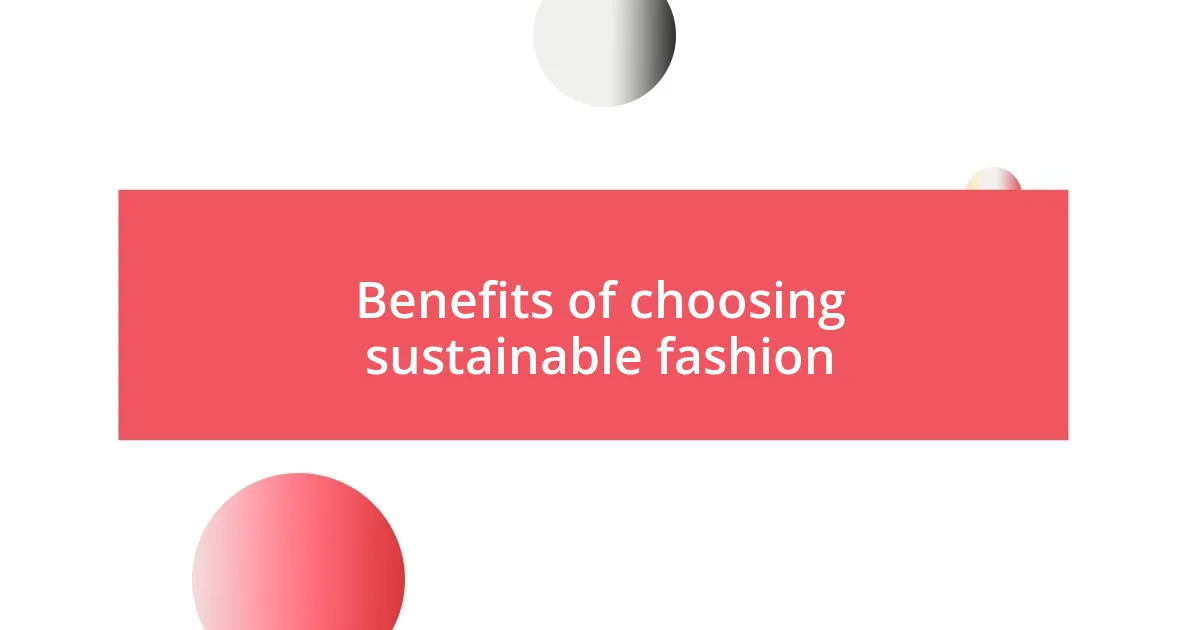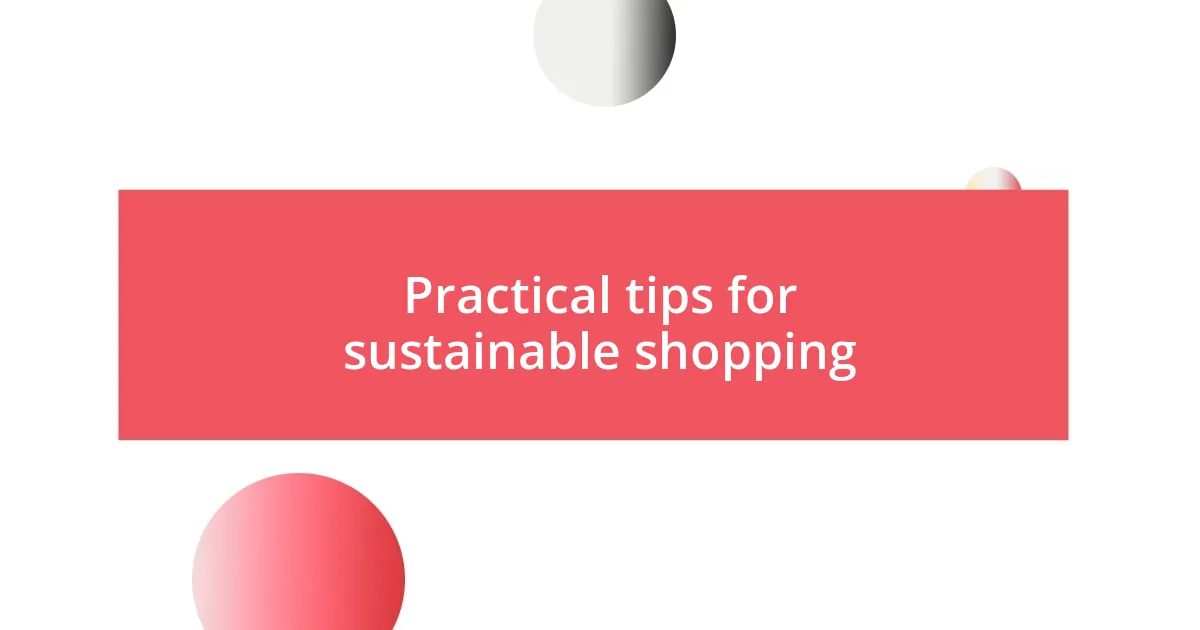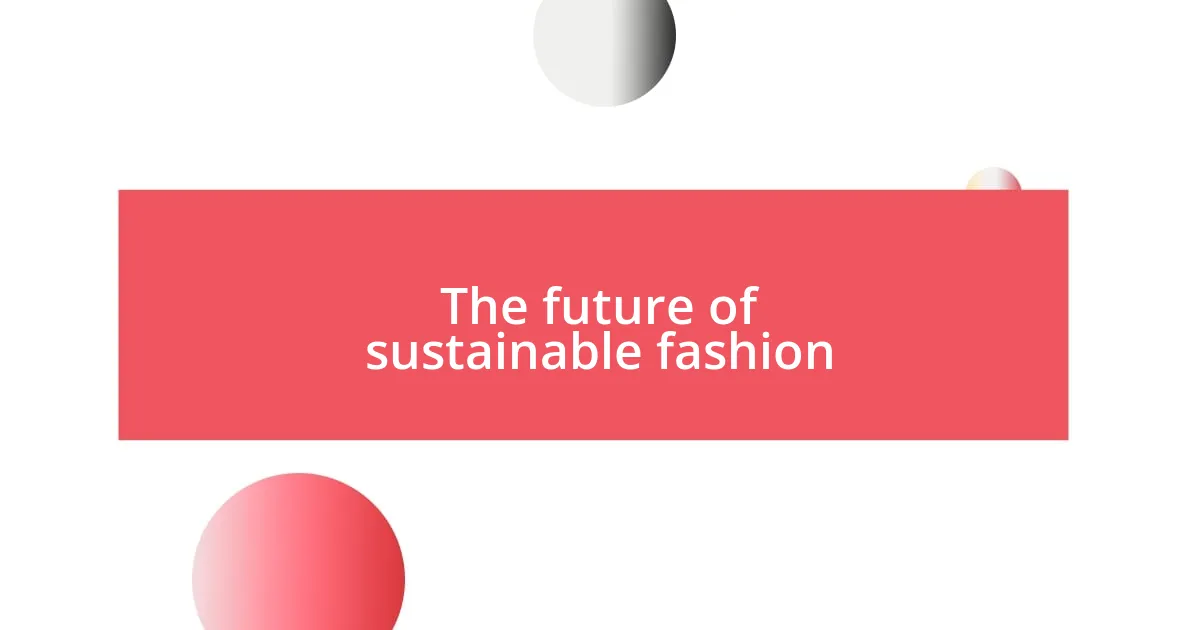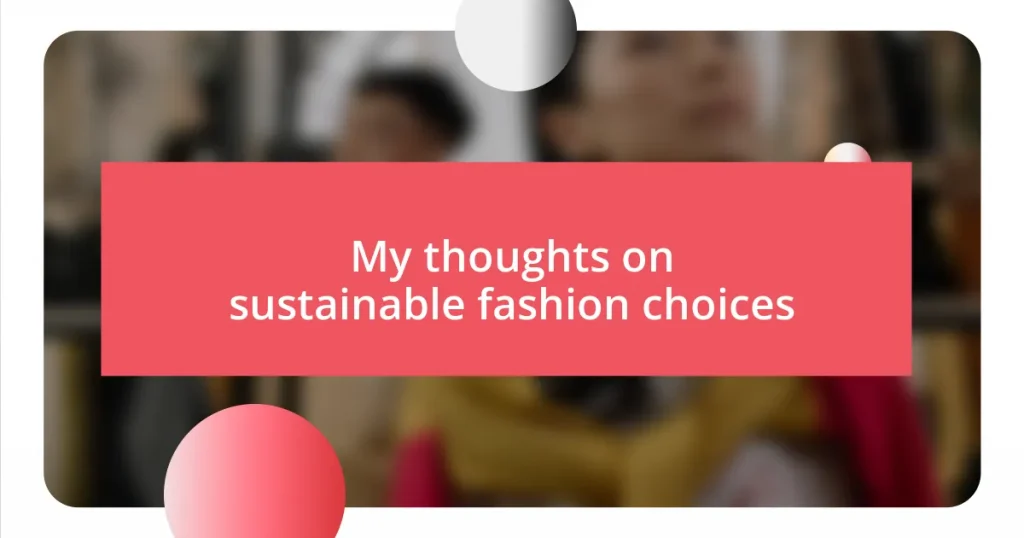Key takeaways:
- Sustainable fashion minimizes environmental impact and promotes ethical practices, encouraging mindful purchasing.
- Choosing sustainable options leads to benefits like reduced environmental impact, higher quality products, and personal empowerment.
- Common misconceptions include the belief that sustainable fashion is always expensive and lacks variety; in reality, it offers diverse styles and can save money long-term.
- The future of sustainable fashion is bright with innovations in recycling and growing consumer demand for transparency and ethical practices in the industry.

Understanding sustainable fashion choices
Sustainable fashion choices revolve around the concept of minimizing environmental impact while promoting ethical practices in the industry. I remember the first time I consciously chose to purchase clothes from a brand that focused on sustainable materials. It was a simple cotton t-shirt, but feeling its softness reminded me how much weight my buying choices carry. Isn’t it empowering to know your purchase can support a brand that values the planet?
As I began to explore my wardrobe, I realized that every item tells a story. For instance, I still wear a vintage dress that I picked up at a local thrift shop. Not only does it have character, but it also sparks conversations about the importance of reusing and recycling fashion. Have you ever thought about the untapped potential of the clothes that just hang in your closet?
Understanding sustainable fashion choices is also about recognizing the lifecycle of a garment. When I learned about fast fashion’s impact on the environment—everything from excessive waste to pollution—I felt a sense of responsibility wash over me. This awareness changed how I view each clothing purchase, prompting me to ask myself: “How will this piece contribute to my life and the world around me?”

Benefits of choosing sustainable fashion
The benefits of choosing sustainable fashion are profound and far-reaching. For me, one of the most significant advantages is the tangible impact on our environment. I remember volunteering for a community clean-up, only to find heaps of discarded clothing that could have been avoided with more mindful purchasing. Every time I choose sustainably, I feel like I’m contributing to a solution rather than adding to the problem.
Here are a few benefits I’ve noticed from my sustainable fashion choices:
– Reduced Environmental Impact: Choosing eco-friendly materials cuts down on harmful waste and resource consumption.
– Higher Quality Products: Sustainable brands often prioritize craftsmanship, resulting in clothes that last longer and require fewer replacements.
– Support for Ethical Practices: A conscious purchase can uplift workers in the fashion industry by promoting fair wages and safe working conditions.
– Personal Empowerment: Each sustainable choice becomes a statement of values, aligning my wardrobe with my beliefs.
– Unique Styles: Emphasizing vintage and thrifted items allows for a more personal style that truly reflects who I am.
By embracing sustainable fashion, I’ve found a sense of pride in my choices, knowing that I’m making strides towards a more responsible and ethical approach to clothing.

Common misconceptions about sustainable fashion
Sustainable fashion is often misunderstood, leading to several misconceptions. One common belief is that sustainable clothing is always prohibitively expensive. While it’s true that some eco-friendly brands may have higher price points, I’ve discovered that investing in quality, durable pieces saves me money in the long run. I recall purchasing a beautifully made jacket that has outlasted multiple fast-fashion counterparts—something I had to replace repeatedly. It’s about valuing longevity over fleeting trends.
Another myth I frequently encounter is that sustainable fashion lacks variety. Initially, I thought my wardrobe would become limited to a palette of earthy tones and loose fits. To my surprise, many sustainable brands offer diverse styles, colors, and designs. I found a sleek dress made from recycled materials that turned heads at a recent gathering. Isn’t it great to realize that you can express your individuality while being environmentally conscious?
Additionally, some people believe that sustainable clothing is just a passing trend. I remember discussing this with a friend who dismissed my passion, claiming it would soon fade away. However, as I see more brands embracing sustainability and consumers demanding ethical practices, it’s clear this is more than a fad. It signals a shift in our collective consciousness toward responsible fashion choices that I’m proud to be a part of.
| Misconception | Reality |
|---|---|
| Sustainable fashion is always expensive | Investing in durable pieces can save money over time |
| Sustainable fashion lacks variety | Many brands offer diverse styles and options |
| Sustainability is a passing trend | It’s a growing movement focused on lasting change |

How to identify sustainable brands
To identify sustainable brands, I always start by checking their transparency about sourcing and production practices. Recently, I stumbled upon a brand that proudly shared their supply chain details, from raw materials to labor practices. It felt reassuring, as I believe that a brand’s commitment to ethical sourcing should never be a secret.
Another key element I look for is certifications and memberships in sustainability initiatives. When a brand holds certifications, like Global Organic Textile Standard (GOTS) or Fair Trade, it indicates a verified commitment to higher environmental and social standards. I remember purchasing a pair of shoes that met several certification criteria, and wearing them gave me a sense of pride knowing they were made responsibly.
It’s also essential to consider the materials used. Personally, I’ve found that brands that prioritize organic or recycled materials not only lessen the environmental impact but often provide a unique touch. I once got a hoodie made from recycled ocean plastic, which sparked conversations everywhere I wore it. Isn’t it exciting to think that our fashion choices can initiate dialogues about sustainability?

Practical tips for sustainable shopping
When it comes to sustainable shopping, I’ve found that making a list before heading out can work wonders. It helps me stay focused and resist impulse buys, which are often the enemy of conscious consumerism. I remember one time I wandered into a store without a plan and left with a bunch of items I didn’t really need—definitely not my finest moment. Have you ever felt that pang of buyer’s remorse after an unplanned shopping spree? I certainly have.
Another practical tip is to embrace second-hand shopping. Thrift stores and online resale platforms can be treasure troves for unique and sustainable finds. Just the other week, I scored a vintage leather bag that not only tells a story but also aligns with my values. It’s like every item holds a little bit of history, don’t you think? Plus, shopping second-hand often saves money, allowing us to invest in quality items while reducing waste.
Lastly, I’ve learned the importance of prioritizing quality over quantity. Instead of buying multiple cheaper items, I focus on fewer, high-quality pieces that I’ll wear for years to come. A few months ago, I really thought hard before buying a classic trench coat. It wasn’t the cheapest option, but now it’s become a staple in my wardrobe, proving that sometimes spending a little more upfront really pays off. Doesn’t it feel gratifying to invest in things that last?

Maintaining a sustainable wardrobe
Maintaining a sustainable wardrobe doesn’t just stop at choosing the right brands; it’s also about the care you give to your clothing. I always make it a point to wash my garments in cold water and hang them to dry. Not only does this practice prolong their life, but it also reduces energy consumption significantly. Have you ever thought about how much energy a dryer uses? It’s a small change that adds up over time and makes me feel like I’m contributing to a better planet.
Another aspect of maintaining sustainability is learning basic repair skills. I can’t tell you how many times I’ve fixed a tear or replaced a button on a favorite shirt instead of tossing it away. This not only saves the item from landfill fate but also creates a deeper connection to my clothing. Don’t you think that mending something imbues it with a new story, making it even more special?
Lastly, I try to conduct a seasonal wardrobe review, sort of like a fashion audit. I take the time to assess what I truly wear and what I can part with. It’s liberating to let go of items that no longer serve me. Recently, I donated several pieces that were just gathering dust in my closet. It felt wonderful knowing they would find new homes while also creating space for items that align more with my current style. Have you ever felt that exhilarating sense of clarity after decluttering? It’s like a fresh start!

The future of sustainable fashion
The future of sustainable fashion is incredibly promising, with emerging technologies weaving a more eco-conscious landscape. I recently learned about innovations in fabric recycling processes that allow brands to create new garments from old textiles. It made me wonder—could this be a solution to the endless cycle of fast fashion? With these advancements, we might finally bridge the gap between style and sustainability.
Moreover, as consumers, we’re becoming more vocal about our values. I remember a conversation I had with a friend who was frustrated by brands that pay lip service to sustainability without real action. This shift is crucial; as more people demand transparency, companies will have to step up their game. It’s exciting to think that our choices can directly influence the industry. Are we ready to be change-makers with every purchase we make?
In addition, community-driven initiatives are gaining momentum, creating spaces for dialogue and collaboration. Not long ago, I attended a local fashion swap event, and the energy in the room was electric as people exchanged clothes and shared stories behind their items. Imagine building a culture where sharing and reusing are as celebrated as buying new. It’s heartwarming to realize that the future of fashion could prioritize connection and sustainability. How empowering would it be to know that our closets can foster a sense of community?













